Technology
The Digital Decade
India’s Journey Towards a Tech-Led Future
Posted On: 12 JUN 2025 10:22AM
Introduction
Over the past 11 years, India has made remarkable progress in its journey towards becoming a digitally empowered society and knowledge economy. From expanding internet access in remote villages to revolutionising public service delivery through digital platforms, the country has bridged the urban-rural divide like never before. The digital economy, which contributed 11.74% to the national income in 2022–23, is projected to grow to 13.42% by 2024–25, driven by advancements in artificial intelligence, cloud computing, and digital infrastructure.
Connectivity and Infrastructure
A robust digital infrastructure forms the backbone of a modern economy. Over the past 11 years, India has significantly expanded mobile networks and improved internet connectivity in rural areas.
Telecom and Internet Penetration
Total telephone connections in India grew from 93.3 crores in March 2014 to 120+ crores in April 2025.
- The overall tele-density in India which was 75.23 % in March 2014 rose to 84.49% in October 2024.
- Urban telephone connections rose to 661.36 million in October 2024 as compared to 555.23 million in March 2014 while rural telephone connections increased from 377.78 million in March 2014 to 527.34 million in October 2024.
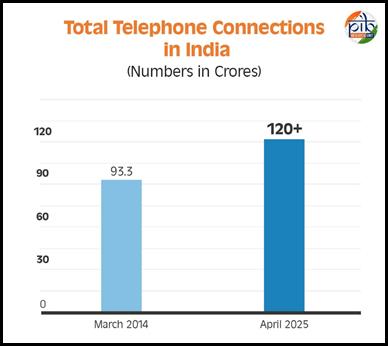
Internet & Broadband Penetration
Internet connections jumped from 25.15 crore in March 2014 to 96.96 crore in June 2024, registering a growth of 285.53%.
- Broadband connections rose from 6.1 crore in March, 2014 to 94.92 crore in August, 2024 growing by 1452%.
- Out of 6,44,131 villages, 6,15,836 villages have 4G mobile connectivity in the country, as of December 2024.
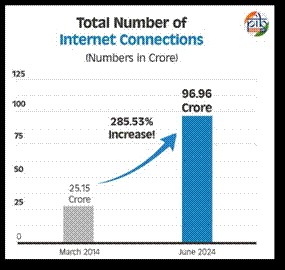
5G and Connectivity
Since 2016, the rapid expansion of 4G coverage brought high-speed connectivity to every corner of the country. Building on this momentum, the launch of 5G in October 2022 further accelerated India’s digital journey, enabling even faster and smarter services. In just 22 months, India set up 4.74 lakh 5G Base Transceiver Stations (BTSs). As of now, 5G services cover 99.6% of the country’s districts, with 2.95 lakh BTSs installed in 2023–24 alone. This leap in infrastructure supports a mobile subscriber base of 116 crore in 2025, highlighting the scale and reach of India’s digital surge.
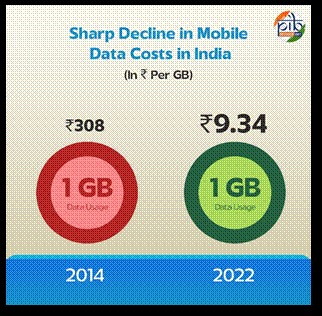
This improved mobile infrastructure has driven a massive surge in internet access. India’s internet user base has grown by 285% over the past 11 years. At the same time, the cost of wireless data has fallen steeply, from ₹308 per GB in 2014 to just ₹9.34 in 2022, making digital services far more affordable.
BharatNet: Linking Villages to the Internet
A major part of this digital push has been about connecting rural India. As of January 2025, the BharatNet project has brought high-speed internet to over 2.18 lakh Gram Panchayats. Nearly 6.92 lakh km of optical fibre cable has been laid under the initiative. Villages that once lacked basic internet access now have digital tools at their doorstep.
Digital Finance and Inclusion
Over the last 11 years, technology has brought financial services closer to people, especially in rural and remote areas.
UPI: Digital Payment Boom
The Unified Payments Interface (UPI) transformed digital transactions across the country. In April 2025, over 1,867.7 crore transactions worth ₹24.77 lakh crore were carried out using UPI in just one month. The (UPI) system is now used by close to 460 million individuals and 65 million merchants. According to the ACI Worldwide Report 2024, India accounted for 49% of global real-time transactions in 2023, reaffirming its position as a global leader in digital payments innovation.
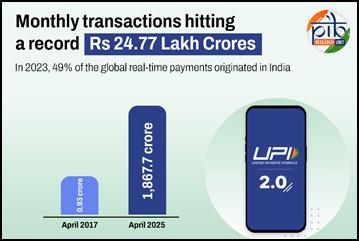
UPI is now live in over seven countries, including the UAE, Singapore, Bhutan, Nepal, Sri Lanka, France, Mauritius, making India a global trailblazer in digital payments. Its growing international adoption is boosting remittances, promoting financial inclusion, and strengthening India's position in the global fintech landscape.
Aadhaar: Building Trust with Technology
The Aadhaar-based e-KYC system has helped simplify processes in both banking and public services. It made verification faster, reduced paperwork, and brought transparency across sectors. As of April 2025, 141.88 crore Aadhaar IDs have been generated. Aadhaar has now become a crucial part of India’s digital backbone, helping people access services with ease.
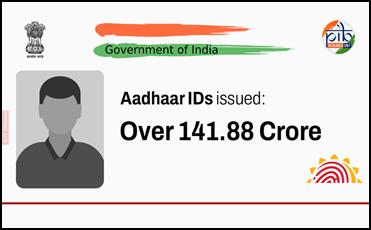
Direct Benefits Transfer: A Cleaner Welfare System
Direct Benefits Transfer (DBT), supported by Aadhaar authentication, changed the way subsidies and welfare payments are delivered. It helped remove fake beneficiaries and saved the government more than ₹3.48 lakh crore between 2015 and March 2023. As of May 2025, the total cumulative amount transferred through DBT has crossed ₹44 lakh crore. People now receive what is rightfully theirs, directly and on time.
The system has also helped clean up beneficiary databases. Over 5.87 crore ineligible ration card holders have been removed, and 4.23 crore duplicate or fake LPG connections have been cancelled, making the welfare system more targeted and transparent.
Open Network for Digital Commerce (ONDC)
Launched in 2022, The Open Network for Digital Commerce (ONDC) is a transformative initiative aimed at democratizing digital commerce. It envisions creating a level playing field for sellers, buyers, and service providers across India, particularly small and medium enterprises (MSMEs).
Key Achievements:
- As of January 2025, the sellers and service providers are spread across 616+ cities expanding the geographical coverage of the ONDC network.
- As of January 2025, there are more than 7.64 lakh sellers/service providers registered on the ONDC platform.
Government e-Marketplace (GeM)
Launched in 2016, Government e Marketplace (GeM), created in a record time of five months, facilitates online procurement of common use Goods & Services required by various Government Departments / Organisations / PSUs.
Key Achievements:
- As of January, 2025, GeM has clocked a GMV of ₹4.09 lakh crore within 10 months of the current Fiscal Year 2024-25, which marks a growth of nearly 50% over the corresponding period last FY.
- GeM has a network of 1.6 lakh+ government buyers and over 22.5 lakh sellers and service providers.

E-Governance: Empowering Citizens, Enabling Change
Over the past 11 years, e-Governance in India has revolutionized the way citizens interact with the government by making services more accessible, transparent, and efficient. Through robust digital platforms, it has empowered both citizens and officials, enhancing ease of governance across the country.
Karmayogi Bharat + iGOT
Karmayogi Bharat, under the Mission Karmayogi National Programme for Civil Services Capacity Building (NPCSCB), is reshaping the learning landscape for civil servants in India. The initiative aims to nurture a future ready civil service by equipping officials with the right Attitude, Skills, and Knowledge (ASK) to deliver efficient and citizen-centric governance.
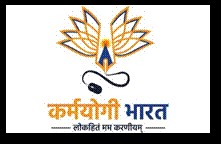
As of May 2025, over 1.07 crore Karmayogis have been onboarded onto the platform, which offers 2,588 courses spanning diverse governance domains. With more than 3.24 crore learning certificates issued, the platform facilitates continuous learning through online, face to face, and blended formats. It also supports peer learning via forums, career path guidance, and robust assessments, building a credible, agile, and capable public workforce aligned with the vision of a New India.
DigiLocker
Launched in 2015, DigiLocker aims at ‘Digital Empowerment’ of citizen by providing access to authentic digital documents to citizen’s digital document wallet. DigiLocker users as of April 2025 reached to a significant number of 51.6 crores.
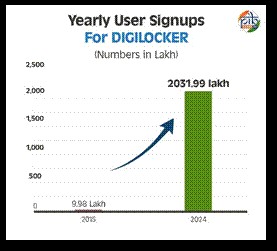
Key Achievements:
- From January 2025 to June 11, 2025, a total of 9.42 crore users signed up, including 33.06 lakh sign-ups in the month of June alone.
- 2031.99 lakh yearly user signups recorded in 2024 as compared to 9.98 lakh signups recorded in 2015.
UMANG
Launched in 2017, UMANG (Unified Mobile Application for New-age Governance) is developed to drive Mobile Governance in India. UMANG provides a single platform for all Indian Citizens to access pan India e-Gov services ranging from Central to Local Government bodies.
Key Achievements:
- 8.21 crore user registrations and 597 crore transactions recorded as of May 2025.
- 2,300 government services are available on the UMANG portal in 23 Indian languages as of May 2025.
Digital Capacity Building
India’s digital transformation is not just about access; it’s also about enabling people and institutions to use technology effectively. Over the past 11 years, this approach has driven inclusive growth, empowered citizens, and strengthened digital governance across the nation.
Pradhan Mantri Gramin Digital Saksharta Abhiyan (PMGDISHA)
The Pradhan Mantri Gramin Digital Saksharta Abhiyan (PMGDISHA) was approved by the Union Cabinet in February 2017 to promote digital literacy and empower rural India through technology. The initiative aimed to make at least 6 crore individuals digitally literate, enabling them to confidently access digital services and information.
Implemented by CSC eGovernance Services India Limited, the scheme leveraged a vast grassroots network of 5.34 lakh Common Service Centres spread across 2.52 lakh Gram Panchayats. As of its formal conclusion on March 31, 2024, the PMGDISHA scheme had enrolled approximately 7.35 crore candidates, with 6.39 crore individuals successfully trained and 4.77 crore certified. This makes it one of the largest digital literacy initiatives globally.
In addition to PMGDISHA, several other initiatives have been launched to expand digital literacy, enhance technical skills, and nurture innovation:
- NIELIT (National Institute of Electronics and Information Technology) Deemed to be University: On July 15, 2024, the Ministry of Education notified NIELIT Ropar and 11 of its units as a Deemed University under a distinct category, with a target to skill 37 lakh candidates over the next five years.
- Skill Development in ESDM(Electronics System Design and Manufacturing) Sector: Under the two ESDM skill development schemes, a total of 4,93,928 candidates have been registered so far. Out of these, 4,93,926 have received training, 3,74,456 have been certified, and 1,37,762 have successfully secured job placements.
- FutureSkills PRIME (Programme for Re-skilling/Up-skilling of IT Manpower for Employability): Under the programme more than 22 lakh candidates signed-up, more than 11 lakh candidates enrolled, more than 5.3 Lakh candidates completed their courses, 11,519 Government Officials trained.
- Information Security Education and Awareness (ISEA) Project: 95,206 candidates trained, 31 awareness programmes conducted.
- Chips to Start-up (C2S) Programme: Under the Chips to Start-up (C2S) Programme, support has been extended to 113 organisations, including 100 academic institutions and R&D organisations, along with 13 start-ups and MSMEs. The initiative has led to the development of 58,652 specialised professionals and the filing of 26 patents, strengthening India’s semiconductor and innovation.
- Visvesvaraya PhD Scheme: Scheme supported 1619 Full-time and 420 Part-time PhD candidates.
Bhashini – Breaking Language Barriers
BHASHINI (BHASHa INterface for India) is a pioneering initiative under the National Language Translation Mission (NLTM), aimed at bridging India’s linguistic diversity through technology. By harnessing the power of artificial intelligence and natural language processing, BHASHINI enables access to digital content and public services in multiple Indian languages. Implemented by the Digital India BHASHINI Division under the Ministry of Electronics and Information Technology, the platform is helping realise the vision of a truly inclusive Digital India.
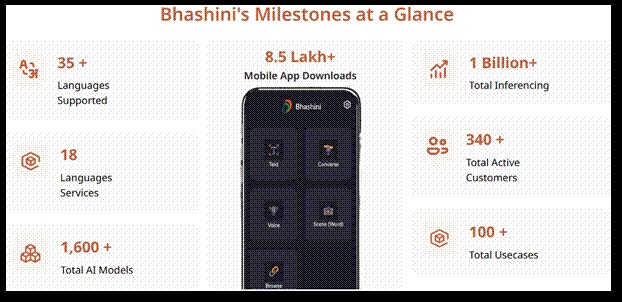
As of May 2025, BHASHINI supports 35+ languages with over 1,600 AI models and 18 language services. It is integrated into widely used platforms such as IRCTC, NPCI’s IVRS systems, and police documentation, making essential services more inclusive and accessible for all. With over 8.5 lakh mobile app downloads, BHASHINI continues to empower citizens to engage with digital platforms in the language of their choice.
Advancing Strategic Tech Capabilities
India is rapidly advancing in cutting-edge technologies to strengthen its position as a global innovation hub. Focused efforts are being made to boost AI capabilities, enhance compute infrastructure, and develop a self-reliant semiconductor ecosystem.
IndiaAI Mission

The IndiaAI Mission, approved by the Union Cabinet under the leadership of the Hon’ble Prime Minister on 7 March 2024, is a landmark initiative to build a comprehensive and inclusive AI ecosystem in India. It focuses on seven strategic pillars: Compute Capacity, Innovation Centre, Datasets Platform, Application Development Initiative, FutureSkills, Startup Financing, and Safe & Trusted AI. With a total outlay of ₹10,371.92 crore over five years, the mission aims to advance responsible AI innovation aligned with national priorities.
As of 30 May 2025, India’s national compute capacity has crossed 34,000 GPUs, laying a strong foundation for AI-led research and development.
India Semiconductor Mission
The India Semiconductor Mission is key to India’s digital transformation, as semiconductors power all modern digital technologies. By boosting local chip manufacturing, it lays the foundation for a self-reliant, faster and more secure digital economy.
The India Semiconductor Mission is a strategic initiative approved by the Government with a total outlay of ₹76,000 crore to build a robust semiconductor and display manufacturing ecosystem in the country. The programme provides 50 percent fiscal support on a pari passu basis for the setting up of Semiconductor Fabs, Display Fabs, Compound Semiconductors, Silicon Photonics, Sensors, and ATMP/OSAT facilities. It also offers a Product Design Linked Incentive of up to 50 percent of eligible expenditure and a Deployment Linked Incentive of 6 to 4 percent of net sales turnover over five years to promote chip design.
The mission aims to boost domestic value addition in electronics manufacturing, reduce reliance on imports and integrate India’s electronics industry with global supply chains. As of May 14, 2025, six semiconductor manufacturing projects had been approved under the programme, with a cumulative investment of over ₹1.55 lakh crore. Already, five semiconductor units are in advanced stages of construction. The latest project, approved on May 14, 2025, is a joint venture between HCL and Foxconn to set up a display driver chip manufacturing plant near Jewar airport in Uttar Pradesh.
Conclusion
India’s digital journey over the past decade has not only transformed services and governance but also laid the groundwork for strong economic growth. Digital industries have been growing at a faster pace than traditional sectors, showing how technology is becoming a key driver of progress. By 2030, the digital economy is expected to make up nearly one-fifth of the country’s total economy. This shift highlights how digital advancements are helping create new opportunities, boost innovation, and make India a leader in the global digital landscape.
References
Click here to see in PDF
Explainer 12/ Series on 11 Years of Government
Santosh Kumar/ Ritu Kataria/ Kamna Lakaria
(Backgrounder ID: 154635)
Visitor Counter : 100